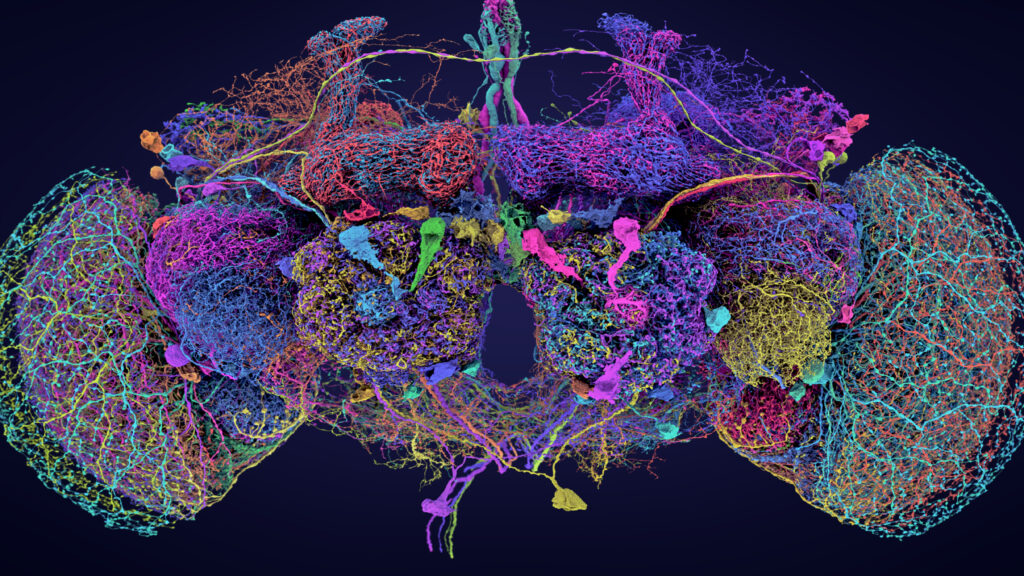Researchers create the largest-ever neural map of a fruit fly’s brain, unlocking new possibilities for understanding neurocircuits and advancing brain disease research.
Mapping the brain is one of the most challenging and ambitious tasks in neuroscience. With over 100 billion neurons and trillions of connections in the human brain, understanding how these connections form neural circuits to govern behavior, cognition, and disease has been a daunting endeavor. Recently, however, researchers have made a major breakthrough in this effort by completing a neural map, or connectome, of the adult fruit fly. This map is the most detailed of its kind and marks a significant milestone in our understanding of the brain’s complex structure and function.
Published in Nature on October 2, 2024, the fruit fly connectome catalogs more than 50 million connections between over 130,000 cells, offering unprecedented insight into how neural circuits operate. This monumental achievement, which involved nearly 50 labs from around the globe, is expected to help answer fundamental questions about how the brain processes information, performs tasks, and goes awry in diseases such as Alzheimer’s and Parkinson’s.
The Significance of the Fruit Fly Connectome
The fruit fly (Drosophila melanogaster) has long been a model organism in neuroscience due to its relatively simple brain and genetic similarities to humans. While it may seem modest compared to the complexities of the human brain, the fruit fly’s brain provides a critical window into understanding how neural circuits work. As John Ngai, director of the National Institutes of Health’s BRAIN initiative, expressed, “I was blown away by the depth of detail of what it can tell us about how neurocircuits work, in a way that was aspirational 10 years ago when we started this whole thing.”
The connectome, described as a detailed wiring diagram of the brain, allows scientists to explore how neurons communicate with one another to produce complex behaviors. By tracing these connections, researchers can better understand how animals perceive their environment, move, learn, and make decisions.
“You can’t fully understand animals’ behaviors without understanding how the brain is wired up,” said Michael Winding, a systems neuroscientist at the Francis Crick Institute. Winding, who helped create a connectome of a fly larva, emphasizes that these maps provide the foundation for deciphering the brain’s complex systems.
AI: The Key to Unlocking Connectomes
Creating a connectome of the fruit fly required slicing its brain into ultra-thin sections, imaging each slice, and then piecing together a three-dimensional atlas of the brain. This process used to be painstakingly slow, as earlier connectomes were created manually, with scientists tracing the connections between neurons by hand. The process was not only labor-intensive but also prone to error.
However, advancements in artificial intelligence (AI) have revolutionized this field. Researchers now rely on powerful AI algorithms to process and analyze massive amounts of data, making it possible to tackle larger and more complex brains. The researchers estimate that completing the fruit fly connectome would have taken a single person 33 years to complete by hand—and thousands of years without the help of AI tools. Today, AI can trace neural connections at a speed and accuracy previously unimaginable.
AI does not completely replace the human touch, though. Scientists still manually proofread and correct the models where AI algorithms make mistakes, ensuring the final connectome is as accurate as possible. But thanks to AI, what once seemed impossible is now becoming a reality, opening up a new era of connectomics.
Before and After Connectomes: A Renaissance in Neuroscience
Sebastian Seung, a computational biologist at Princeton University and part of the research team, humorously suggested that the history of neuroscience can be divided into two eras: “BC and AC”—before and after connectomes. The implications of having a complete connectome of the fruit fly are profound, and researchers are only just beginning to scratch the surface of the potential discoveries that this data could unlock.
The connectome allows neuroscientists to ask specific questions about how the brain functions on a cellular level. For example, with the fly connectome, researchers can investigate how neural circuits coordinate behaviors such as walking, grooming, and visual processing. These insights could have broader implications for understanding more complex brains, including our own.
Looking Toward Larger and More Complex Brains
While the fruit fly connectome is a monumental achievement, the next big goal for neuroscientists is creating a connectome of the mouse brain—the most common mammal used in neuroscience research. This would represent a significant step toward the eventual goal of mapping the human brain.
However, the challenges of scaling up to larger and more complex brains are immense. As Forrest Collman, a neuroscientist at the Allen Institute and co-author of the paper, explained, “It is not technically feasible to do a human connectome at the moment.” The sheer volume of data required to store a complete map of the human brain would be in the neighborhood of a zettabyte, roughly equivalent to all of the data used on the internet in a year.
Despite these challenges, researchers are optimistic. Several ongoing projects are working to improve imaging techniques and reconstruction algorithms, with the aim of making connectomes of larger brains more feasible. In the next decade, creating a complete connectome of a mouse brain is within reach. While a human connectome is much further away, creating detailed maps of specific regions of the human brain may be achievable in the near future.
Implications for Brain Disease Research
Beyond understanding normal brain function, the fruit fly connectome has critical implications for studying diseases that affect the brain. Neural circuit disorders, such as Alzheimer’s, Parkinson’s, and schizophrenia, are caused by dysfunctions in the way neurons communicate. The connectome offers a blueprint that researchers can use to explore how these diseases disrupt normal brain function and identify potential targets for treatment.
“The connectome is a critical piece in this larger continuum of research that is going to be necessary not just to treat the symptoms of disease, but hopefully one day, to cure them,” Ngai said. “Because you can’t fix what you don’t understand, and having these connectomes is going to be key for understanding what is really tantamount to circuit disorders.”
The Path Ahead: From Fruit Flies to Humans
The completion of the fruit fly connectome marks an important milestone, but the journey toward understanding the human brain is far from over. As technology continues to advance, so too does the potential for unlocking the mysteries of the brain.
For now, the fruit fly remains a critical model for neuroscientists, providing valuable insights that could lead to better treatments for neural disorders in humans. And with each new connectome, researchers come one step closer to the ultimate goal: a complete map of the human brain.
Conclusion
The creation of the fruit fly connectome is a groundbreaking achievement in neuroscience, offering an unprecedented glimpse into the brain’s wiring and how it governs behavior. As researchers continue to build on this foundation, the connectome could revolutionize our understanding of neurocircuits, bringing us closer to unraveling the mysteries of brain function and disease. With AI enabling faster and more accurate mapping, the future of neuroscience looks brighter than ever.







